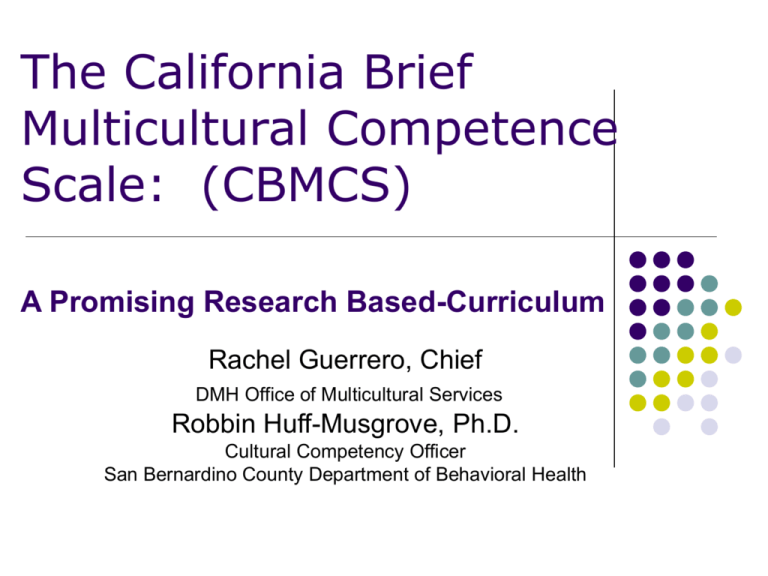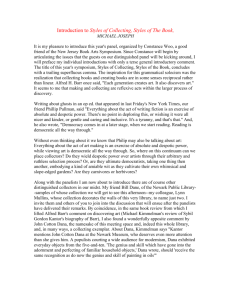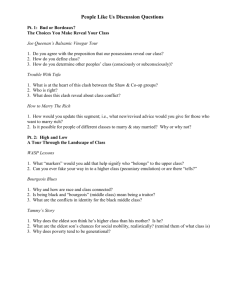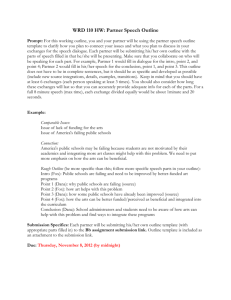
The California Brief
Multicultural Competence
Scale: (CBMCS)
A Promising Research Based-Curriculum
Rachel Guerrero, Chief
DMH Office of Multicultural Services
Robbin Huff-Musgrove, Ph.D.
Cultural Competency Officer
San Bernardino County Department of Behavioral Health
Acknowledgements
Richard Dana, Portland State University
Glenn Gamst, University of La Verne
Aghop Der-Karabetian, University of La Verne
With Contributions From
Leticia Arellano-Morales, University of La Verne
Marya Endriga, California State University, Sacramento
Robbin Huff-Musgrove, Patton State Hospital
Gloria Morrow, Private Practice
With Generous Support From
California Department of Mental Health - Office of Multicultural Services
Eli Lilly Foundation
California Mental Health Directors Association
California Institute of Mental Health
University
of La Verne, La Verne, CA
Copyright Dana, Gamst, Der-Karabetian 2006
2
Objectives
Provide an historical overview of the CBMCS and
the training program in the State of California’s
Department of Mental Health and County Mental
Health Departments
Provide an overview of the construction and
development of the CBMCS and the training
program
Provide an overview of the four training Modules:
1.
2.
3.
4.
Multicultural Knowledge
Awareness of Cultural Barriers
Sensitivity and Responsiveness to Consumers
Sociocultural Diversities
Copyright Dana, Gamst, Der-Karabetian 2006
3
Objectives
Share plans for distributing the CBMCS and
training program to other Mental Health and
Human Service Agencies.
Copyright Dana, Gamst, Der-Karabetian 2006
4
CBMCS and Training Program
in California DMH and County
Mental Health Departments
CBMCS Development
Goal: Development of a Multicultural
Competence Scale easily administered and
scored1999 Scale Development
2000 lengthy Questionnaire 5 Scale (137 Q)
2000-01 #1,244 CA. practitioners participated
2001 Client/Family members reviewed
2001-02 Training Manual- Richard Dana PhD
2002-03 From Manual to training program
Copyright Dana, Gamst, Der-Karabetian 2006
6
THE CALIFORNIA BRIEF
CULTURAL COMPETENCE SCALE
(CBMCS)
Consists of 21 items – 4 factors (see handout)
1.
Multicultural Knowledge: Issues of acculturation,
racial/ethnic identity, language, etc.
2.
Awareness of Cultural Barriers: Challenges people of color
experience accessing mental health services.
3.
Sensitivity to Consumers: What does it mean to be a person of
color AND a mental health consumer of services.
4.
Sociocultural Diversities: (formerly Nonethnic Ability) Issues of
gender, sexuality, aging, social class, and disability.
Cronbach’s alpha ( a measure of internal consistency) ranged
from .90 to .75.
Copyright Dana, Gamst, Der-Karabetian 2006
7
Utility & Application
The CBMCS can be used by an agency to identify the training
needs of the agency staff.
The Unique aspect of this scale is that it has its own Training
Program that”flows” from the scale. Agencies can use the
CBMCS scale to target which staff should receive a
particular module.
Agencies could run staff through all 4 modules.
The CBMCS scale could be used as a pre-post measure of
training effectiveness, along with client outcome or
satisfaction measures.
Copyright Dana, Gamst, Der-Karabetian 2006
8
The California Brief
Multicultural
Competence Scale-Based
Training Program
For each of the 4 subscales identified by
the CBMCS, we have developed an 8 hour
Power Point training module. Resulting in
4X8 hours = a 32 hour multicultural
training program in four modules.
Copyright Dana, Gamst, Der-Karabetian 2006
9
Development CBMCS Training
Summer 2004, 40 MH cultural competence experts
participate in review of CBMCS Training,
representing 14 counties and state DMH
CBMS 4 Modules were revised
Summer 2005/06 15 experts revised the CBMCS
training from MH provider input
Fall 2006 Pilot of CBMCS begins
The CBMCS represents a true partnership between
State and Local Mental Health and University
Evidence based research and Development
Copyright Dana, Gamst, Der-Karabetian 2006
10
Selected CBMCS Pilot sites
5 Counties selected from original 14 counties
that participated in early review.
Kern County – training completed Oct. 2006
San Bernardino – training completed Dec.
2006
Sacramento – training completed Feb. 2007
Santa Clara – training completed Feb. 2007
San Francisco
All pilots to be completed by February 2007
Copyright Dana, Gamst, Der-Karabetian 2006
11
Overview of the CBMCS
Training Modules
I.
II.
III.
IV.
Multicultural Knowledge
Awareness of Cultural Barriers
Sensitivity and Responsiveness
to Consumers
Sociocultural Diversities
Module I : Multicultural
Knowledge
Purpose:
This module focuses on the four
racial/ethnic/cultural groups that have experienced
the greatest levels of historical oppression in the
U.S.; however this training allows for inclusion of
other racial/ethnic/cultural groups and communities.
Today the Surgeon General reports that these same
groups continue to experience disparities in access
to, quality of, and outcomes of mental health care.
Copyright Dana, Gamst, Der-Karabetian 2006
13
Module I Overview
1.
2.
3.
4.
5.
6.
7.
8.
CBMCS Development
Cultural Competency Defined
Historic & Contemporary Overview of the Four Major
Ethnic Groups in the U.S.
Health Disparities
Recognizing Deficiencies in Research Conducted on
Minorities
Psychosocial Factors to Consider When Providing
Services to a Culturally Diverse Consumer
Population
Providing Culturally Competent Mental Health
Assessment and Diagnosis
Understanding and Evaluating Wellness, Recovery,
and Resiliency
Copyright Dana, Gamst, Der-Karabetian 2006
14
Goals & Objectives
To obtain historic, contemporary, and demographic
information on the four main ethnic/racial/cultural
groups in the U.S.
To examine sources of bias that have resulted in
inadequate services and curtailed utilization of
services available to these groups.
To become aware of empirical knowledge concerning
the mental health status of ethnic, racial, cultural
groups.
To recognize deficiencies in related research.
To explore implications for practice.
Copyright Dana, Gamst, Der-Karabetian 2006
15
Setting the Tone
This process may generate strong emotions.
Need to set and agree to ground rules.
Respect
Confidentiality
Active listening
Nonjudgmental comments
Group input
Address comments to Trainer/Facilitator
Copyright Dana, Gamst, Der-Karabetian 2006
16
Transitional Stages of Change
Denial (of differences)
Defense (against differences)
Minimization of differences (bury differences under cultural
similarities)
Acceptance ( of cultural differences)
Adaptation (of behavior and thinking to that difference)
Integration (the application of ethnorelativism, becoming a
part of and apart from a given cultural context.)
Determining one’s level of competency
(M.J. Bennett, 1986)
Copyright Dana, Gamst, Der-Karabetian 2006
17
Weaknesses & Biases
Lack of psychological research on ethnic minorities:
Examination of journal articles from 1970-1989 by Graham
(1992) found only 3.6% included African Americans.
Iwamasa & Smith (1996) found only 1.3% of articles
focused on U.S. ethnic minority groups.
Delgado-Romero (2005) found that only 22% of research
participants were from ethnic minority groups in a study of
3 counseling journals over 10 years.
Generalizability of psychotherapeutic findings
without cross cultural validation.
(Sue S., 1999)
Copyright Dana, Gamst, Der-Karabetian 2006
18
Within Group Differences
Racial/Ethnic Identity Development
Cultural Self
Acculturation Status
Socioeconomic Status
Copyright Dana, Gamst, Der-Karabetian 2006
19
DSM-IV Outline For Cultural
Formulations
1.
2.
3.
4.
5.
Cultural identity of the individual.
Cultural explanation of the individual’s
illness.
Cultural factors related to psychosocial
environment and levels of functioning.
Cultural elements of the relationship
between the individual and the clinician.
Overall cultural assessment for diagnosis
and care.
(American Psychiatric Association, 2000)
Copyright Dana, Gamst, Der-Karabetian 2006
20
Module II Awareness of
Cultural Barriers
Purpose:
Cultural Self-awareness and understanding
through self-evaluation
Exploration of white privilege
Increase awareness of racism,
discrimination and oppression and its
impact on service delivery
Copyright Dana, Gamst, Der-Karabetian 2006
21
Module II Overview
Highlights
2.
Context of Barriers
3.
Awareness of Self
a. Cultural Self-Awareness
b. Worldview
c. Racial/Ethnic Identity
4.
Awareness of Others
a. Oppression
b. Racism
c. Privilege
d. Gender Differences
e. Sexual Orientations
5. Clinical Implications
Copyright Dana, Gamst, Der-Karabetian 2006
1.
22
Goals & Objectives
To become aware of personal values, beliefs, and
ethnic/racial/cultural background.
To become aware of the effects of discrimination
and oppression.
To become aware of privilege, bias, and
stereotypes.
To become aware of service delivery implications.
To apply self-awareness to the repertoire of
multicultural skills.
Copyright Dana, Gamst, Der-Karabetian 2006
23
Self Awareness Overview
Self Awareness Definition
Worldview
Racial/Ethnic Identity Models
Cultural Self-Awareness
Who Are You? (WAY)
Conocimiento (Self-knowledge) exercise
Worldview & Values (Scale to Assess
Worldview; SAWV)
Copyright Dana, Gamst, Der-Karabetian 2006
25
Awareness of Others
Expression of Power
Oppression
Racism
A Difference of Color
Gender Differences
Sexual Orientation
Clinical Implications
Multicultural awareness helps to ensure that
appropriate assessment, diagnosis, and treatment
are provided to culturally diverse consumers.
Provider self-awareness is important for
improving clinical outcomes because providers
and consumers exchange worldviews, values,
attitudes, beliefs, and experiences as part of the
therapeutic process.
Self-awareness assists in improving the overall
quality of services.
Copyright Dana, Gamst, Der-Karabetian 2006
27
Module III: Sensitivity to
Consumer
Purpose:
1.
Increased sensitivity and responsiveness to
consumers by focusing on the providers
expectations and the therapeutic relationship
2.
Increase appreciation of the multiple roles of
Advocacy in stimulating hope and faith in
multicultural consumers
3.
Increase awareness of the pervasive, chronic and
personal effects of racism on consumers of mental
health services and an introduction to provider
behaviors that can mitigate the effects of
consumers experiences with racism
Copyright Dana, Gamst, Der-Karabetian 2006
28
Module III Overview
1.
2.
3.
4.
5.
6.
7.
8.
9.
Highlights
Sensitivity and Responsiveness Defined
Communication Styles
Stereotyping
Racism and Mental Health
Racism Effects on Consumers
Use of Active Engagement to Ameliorate Effects of Racism
Guiding Principles for Sensitive and Responsive Mental Health
Practice
Clinical Implications
Copyright Dana, Gamst, Der-Karabetian 2006
29
Goals & Objectives
To improve sensitivity to the experiences and
worldview of consumers.
To improve sensitivity and responsiveness to
the effects of racism, oppression,
discrimination on consumers of mental health
services.
To improve sensitivity to the impact of
provider and consumer social values and
communication styles.
Copyright Dana, Gamst, Der-Karabetian 2006
30
Sensitivity and Responsiveness
to Consumers
Sensitivity refers to the provider’s ability to understand
consumers’ experiences of racism, oppression and
discrimination.
Provider responsiveness impacts the experience of
being a mental health consumer and her/his level of
functioning.
Sensitivity refers to providers’ acknowledgment and
understanding that they may hold different social
values and communication styles than the consumers
they serve.
Responsiveness to these differences may improve the
quality of the therapeutic relationship
Copyright Dana, Gamst, Der-Karabetian 2006
31
Cultural Influences on
Communication
Language and thinking patterns vary based
on culture but heavily influence the
therapeutic process.
Language influences how persons think,
speak, and write. Culture also determines
how feelings and emotions are expressed.
Linear thinking styles are commonly
embedded in therapeutic processes.
Kaplan (1989)
Copyright Dana, Gamst, Der-Karabetian 2006
32
Sensitivity and Responsiveness:
Stereotyping
Providers need to recognize the
ethnic/racial/cultural stereotypes they might
have in order to minimize any negative
impact when providing mental health
services.
Copyright Dana, Gamst, Der-Karabetian 2006
33
Racism and Mental Health:
Barriers to Service
Provider’s Perspective
Failure to acknowledge the long history of racism
and its impact on mental health services for
people of color.
Failure to acknowledge the pervasiveness of
racism in the lives of consumers.
Failure to acknowledge how individual,
institutional, cultural racism has influenced
conventional treatment modalities, diagnoses,
and assessment.
Copyright Dana, Gamst, Der-Karabetian 2006
34
Racism Effects on Consumers:
Racism as a Stressor
Racism related life events (e.g., racial slur).
Vicarious racism experiences (e.g., racial profiling).
Daily racial microstressors (e.g., being ignored in
line).
Chronic contextual distress (e.g., employment and
housing barriers).
Collective experiences (e.g., Confederate flag).
Transgenerational trauma (e.g., Japanese American
internment, and slavery).
(Harrell, 2000)
Copyright Dana, Gamst, Der-Karabetian 2006
35
Active Engagement:
Service Delivery Social Etiquette
Service delivery social etiquette refers to
credible culture-specific styles of
etiquette that show respect and facilitate
the therapeutic process.
Copyright Dana, Gamst, Der-Karabetian 2006
36
Implications for Treatment
Cultural sensitivity and responsiveness
facilitates treatment and results in better
outcomes for diverse clients.
Conversely, cultural insensitivity and lack of
responsiveness reduces treatment
effectiveness.
Copyright Dana, Gamst, Der-Karabetian 2006
37
Culturally Responsive
Behavior Leads To:
Low attrition
High consumer satisfaction
High consumer motivation
High utilization
Consumer rating of counselor as credible,
empathic, and trustworthy
Positive ratings on outcome measures
Ridley et al., 1994
Copyright Dana, Gamst, Der-Karabetian 2006
38
Module IV: Sociocultural
Diversities
Purpose:
1.
Obtain information about members of sociocultural
groups in which ethnicity may not be the major or
immediate focuses of professional attention: age,
gender, sexual orientation, social class, physicalmental intactness and disability status.
2.
Increase awareness of bias, oppression and
discrimination experienced by members of
sociocultural groups
3.
Obtain information about best practices and
treatment considerations for members of
sociocultural groups
Copyright Dana, Gamst, Der-Karabetian 2006
39
Module IV Overview
1.
2.
3.
4.
5.
6.
7.
8.
9.
10.
Highlights
Knowledge, Awareness and Sensitivity to:
Sociocultural Diversities
Older Adults
Men and Women
Sexual Orientation/Identities
Socioeconomic Status (SES)
Persons with Disabilities
Interaction Among Multiple Identities
Identifying Sources of Personal – Professional Bias
Prejudice/Discrimination
Copyright Dana, Gamst, Der-Karabetian 2006
40
Goals & Objectives
To extend the parameters of diversity beyond
the limits of ethnic/racial populations.
To improve the delivery of socioculturally
competent services to diverse populations.
To explore the interactions of multiple human
identity components.
Copyright Dana, Gamst, Der-Karabetian 2006
41
Sociocultural
Diversities
Older Adults
Gender & Culture
Sexual Orientation/ Identities
Socioeconomic Status (SES)
Persons with Disabilities
Older Adults: Knowledge
The older population in the U.S. is growing.
Those 65 and older have exceeded the growth rate
of the population as a whole.
By the year 2030 those 65> will constitute 20% of
the population.
Those 85 > are the fastest growing part of the older
adult population.
Because females live longer than males, at age 65
there are only 39 older men for every hundred
women.
(Sue & Sue, 2000)
Copyright Dana, Gamst, Der-Karabetian 2006
43
Ageism
Provider Biases (Specific)
Depression is normal for older adults.
Psychotherapy for depression is ineffective for
older adults.
( Positive Bias) Memory lapses in the aged don't
have to signify anything pathological, therefore
they do not need to be referred to a mental health
professional for evaluation.
Substance abuse is not an issue for older adults.
(APA, 2005)
Copyright Dana, Gamst, Der-Karabetian 2006
44
Gender & Culture Overview
Key Terms
The relationship between culture, and
gender
role conflict in the four major ethnic groups.
Culture as a foundation in assessment and
treatment of mental health and adjustment
issues associated with gender role conflict.
(Canales, 2000)
Copyright Dana, Gamst, Der-Karabetian 2006
45
Sexual Orientation: Key Terms
“Sexual orientation is the interaction between affect
and cognition such that it produces attraction, erotic
desire, and ultimately philia [affinity] for members of
the opposite gender, the same gender, or both.”
(Alderson, 2003)
Copyright Dana, Gamst, Der-Karabetian 2006
46
Knowledge
Based on a national survey, it is estimated
that about 7% of all adults regard themselves
as homosexual or bisexual.
Men
Women
Heterosexual
91%
95%
Homosexual
4%
2%
Bisexual
5%
3%
(Janus & Janus, 1993)
Copyright Dana, Gamst, Der-Karabetian 2006
47
Awareness
Providers must become aware of the following:
Her or his attitude and knowledge of gay, lesbian, and
bisexual consumers, including the need to seek
consultation and to make appropriate referrals.
One’s assumptions, biases and values regarding
homosexuality, and the impact on the delivery of services
to gay, lesbian, and bisexual consumers.
The impact of social stigmatization (i.e., prejudice,
discrimination, and violence) on mental health.
Within group differences that exist within the
gay/lesbian/transgendered community.
APA (1998)
Copyright Dana, Gamst, Der-Karabetian 2006
48
Mental Health Issues
Few differences exist between heterosexual, homosexual, and
bisexual individuals on overall psychological functioning.
Stress related to stigmatization increases the risk of suicide
attempts, substance abuse, and emotional distress.
Stress related to health issues, such as:
HIV/AIDS
Grief, loss & depression due to loss of parental support,
and/or loss of friends and loved ones.
Stress related to discrimination, oppression, and, violence.
Stress related to identity development/coming out process.
APA (1998)
Copyright Dana, Gamst, Der-Karabetian 2006
49
Socioeconomic Status (SES)
“Despite the progress in all areas of human
rights, the goals of the universal declaration
remains elusive for the men, women, and
children who still live in poverty. It is time we
recognized poverty for what it is; a brutal
denial of human rights for the 1.3 billion who
live on less than 1 U.S. dollar per day.”
(Speth, 1998)
Copyright Dana, Gamst, Der-Karabetian 2006
50
Health Disparities
Race & Ethnicity is disproportionately associated
with poverty and health disparities.
The Institute of Medicine’s 2003 book titled “Unequal Treatment”
indicates that racial/ ethnic minorities experience
disproportionate health disparities as compared to White
populations (Institute of Medicine, 2003).
Mental health services are plagued by disparities in the
availability of and access to its services, and that these
disparities are viewed readily through the lenses of racial and
cultural diversity, age, and gender (U.S. DHHS, 2001).
A major finding of the U.S. DHHS Report is that racial and ethnic
minorities bear a greater burden from unmet mental health needs
and thus suffer a greater loss to their overall health and
productivity (U.S. DHHS, 2001).
(LaViest, 2005)
Copyright Dana, Gamst, Der-Karabetian 2006
51
Mental Illness and
Socioeconomic Status
People from lowest socioeconomic strata are 2-3 times more
likely to have a mental disorder and higher levels of distress than
those in higher strata.
Poverty increases risk for mental disorders through greater
exposure to stressful environments (e.g., violence,
unemployment) and less buffering from social or material
resources.
Conversely, having a mental disorder increases risk for poverty
through reduced functioning and productivity.
Poverty and race are intertwined due to legacy of racism and
discrimination.
Even within impoverished environments, there may exist multiple
protective factors that increase resilience and limit mental illness.
(DHHS, 2001; Ungar, 2005)
Copyright Dana, Gamst, Der-Karabetian 2006
52
Disabilities: Knowledge
According to the 2000 Census:
49.7 million persons (19.3%) reported some type of
long lasting disability. Of this group:
6.3% had a sensory disability (sight, hearing)
8.2% had physical/mobility limitations
Disability rates by race/ethnicity:
24.3% African American
24.3% American Indian/Native Alaskan
20.9% Hispanic
19% Hawaiian/Pacific Islander
18.3% White, not Hispanic
16.6% Asian
(Waldrup & Stern, 2003)
Copyright Dana, Gamst, Der-Karabetian 2006
53
Cultural Perspectives
Regarding Disability
Cultural values impact how individuals and families
deal with disabilities.
Asian Americans: Disability may be seen as
punishment for having sinned and creates shame.
Mothers may believe they did something wrong
during pregnancy (Stone, 2005).
Latinos: Disability may be seen as an act of God or
as a punishment from God. Concern about about
economic impact of the disability. Gender role
conflicts may occur (Marini, 2001).
Copyright Dana, Gamst, Der-Karabetian 2006
54
Treatment Considerations
Providers are seldom trained to work with
clients with disabilities.
Providers need to address their discomfort in
working with consumers with disabilities and
recognize that they are also subject to
disability prejudice.
Copyright Dana, Gamst, Der-Karabetian 2006
55
Identity Map Exercise
Education
SES
Marital/family
status
Sexual
Orientation
AGE
Gender
Physical
Health
Religion
Racism/
oppression
experiences
Copyright Dana, Gamst, Der-Karabetian 2006
56
Highlights & Challenges
Self-awareness: Personal insight, and transparency
Increased empathy for others
Camaraderie: bonds established between participants through
personal sharing
Increased desire to promote social change in their agencies
Defensiveness to group differences and characterizations
Some feelings of guilt, shame, and anger from non-ethnic racial
minorities
Initial resistance by non-clinical staff
Initial resistance from mandatory attendees
Copyright Dana, Gamst, Der-Karabetian 2006
57
Plans for Distribution of
the CBMCS and Training
Program
Next Steps







